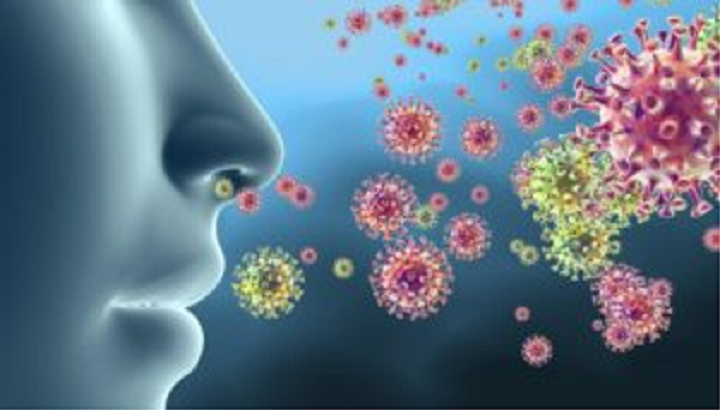A new study conducted by the University of Bristol Aerosol Research Centre in the United Kingdom found that the SARS-CoV-2 virus loses 90 percent of its virulence within 20 minutes after being exhaled into the air. Further, researchers concluded that the virus loses 50 percent of its ability to spread after only 10 minutes of being airborne in an average office setting.1 2 3 4 5
The lead researcher on the Bristol study, professor of chemistry Jonathan Reid, DPhil, said:
People have been focused on poorly ventilated spaces and thinking about airborne transmission over meters or across a room. I am not saying that doesn’t happen, but I think still, the greatest risk of exposure is when you are close to someone. When you move further away, not only is the aerosol diluted down, there are also less infections by this because the viruses lost infectivity (as a result of time).1 2
“It means that if I’m meeting friends for lunch in a pub today, the primary [risk] is likely to be me transmitting it to my friends, or my friends transmitting it to me, rather than it being transmitted from someone on the other side of the room,” Dr. Reid said.2 3 6 “When you move further away, not only is the aerosol diluted down, there’s also less infectious virus because the virus has lost infectivity [as a result of time].”4
Humidity in Air Raises Infection Risk
According to the Bristol study, which has yet to be peer-reviewed, the SARS-CoV-2 virus’s level of infectiousness also depends on the degree of humidity in the air. In an environment of less than 50 percent humidity, the virus loses its ability to infect within five to 10 seconds. At 90 percent humidity, about 52 percent of the virus remains active in the air after five minutes, dropping to 10 percent after 20 minutes. 1 2 4 5
An article in The Guardian reported that “as the viral particles leave the relatively moist and carbon dioxide-rich conditions of the lungs, they rapidly lose water and dry out, while the transition to lower levels of carbon dioxide is associated with a rapid increase in pH (“potential of hydrogen”).” Apparently, both factors contribute to disrupting SARS-CoV-2’s ability to infect people. But the speed at which the viral particles dry out depends on the relative humidity of the environment.2
SARS-CoV-2 is Active in Air and on Surfaces in Different Amounts for Different Time Periods
Previous studies done on SARS-CoV-2 concluded that the virus could remain active in the air for hours.6 7 8 One study by the U.S. National Institute of Allergy and Infectious Diseases (NIAID) last year found the virus could remain active in the air for up to three hours, but that by the third hour it had lost 87.5 percent of its ability to infect other people.9
Another study published in the New England Journal of Medicine by researchers from the Johns Hopkins School of Medicine in 2020 also detected the virus in the air for three hours.10
Based on both the NIH and Johns Hopkins studies (and other studies), the greater chance of being infected by the SARS-CoV-2 virus comes through contact via surfaces, rather than air. NIH and Johns Hopkins researchers found that the virus could remain active on cardboard for 24 hours and on plastic and stainless steel for up to three days.9 Professor of cell biology Carolyn Machamer, PhD of Johns Hopkins, however, noted:
What’s getting a lot of press and is presented out of context is that the virus can last on plastic for 72 hours—which sounds really scary. But what’s more important is the amount of the virus that remains. It’s less than 0.1% of the starting virus material. Infection is theoretically possible but unlikely at the levels remaining after a few days. People need to know this.10
The Bristol study looked at three SARS-CoV-2 variants, including Alpha. Researchers plan to start experiments on the Omicron variant during the next few weeks.1 3 5
If you would like to receive an e-mail notice of the most recent articles published in The Vaccine Reaction each week, click here.
Click here to view References:1 Ali S. New study says air knocks down COVID-19 infection rate by 90 percent. The Hill Jan. 11, 2022.
2 Das D. COVID Loses 90% Of Its Contagion Capacity 20 Minutes After Becoming Airborne: New Study. RepublicWorld.com Jan. 14, 2022.
3 Geddes L. Covid loses 90% of ability to infect within 20 minutes in air – study. The Guardian Jan. 11, 2022.
4 Anghel I. Covid Loses Most Ability to Infect After 20 Minutes in Air. Bloomberg Jan. 13, 2022.
5 Oswin HP et al. The Dynamics of SARS-CoV-2 Infectivity with Changes in Aerosol Microenvironment. medRxiv Jan. 10, 2022.
6 McNeice A. Study increases understanding of airborne transmission. China Daily Global Jan. 13, 2022.
7 U.S. National Institutes of Health. Study suggests new coronavirus may remain on surfaces for days. Mar. 24, 2020.
8 TWC India Edit Team. Coronavirus Can Survive For Three Hours in Air, Up to Three Days on Plastic and Steel: Study. TWC India Apr. 19, 2021.
9 Vinetz J. How long does coronavirus last in the body, air, and in food? Medical News Today Oct. 15, 2020.
10 Volkin S. How Long Can The Virus That Causes COVID-19 Live On Surfaces? Hub Mar. 20, 2020.













6 Responses
Link to original study?
https://www.medrxiv.org/content/10.1101/2022.01.08.22268944v1.full.pdf
Link to original preprint
The claim that increasing humidity results in greater infection is the opposite of what I have ever found on this topic, even pre-Covid. Studies have shown that drier air creates the capability for longer suspension of particulates increasing the risk for spread of infection.
https://www.hsph.harvard.edu/news/hsph-in-the-news/op-ed-humidity-can-aid-in-the-fight-against-covid-19/
https://magazine.scienceconnected.org/2020/05/humidity-and-respiratory-virus-transmission/
https://www.news-medical.net/news/20200818/Study-shows-coronavirus-thrives-in-dry-air-with-low-humidity.aspx
Yes, and Mercola had an article that they found that as Covid was declining here, in the northern hemisphere, in summer ’20, it was INCREASING in the southern hemisphere. And this is despite that it travels around the world at the same time, as people are flying all over. The only plausible explanation is that as people use the heat more, the humidity is lowered, as the air gets dryer. (This is, of course, another good reason to get a humidifier.)
And, as note in one of the links you provided, properly humidified air helps the immune system as well, so that is another plus! TY!
Interesting food for thought because if this it is true that “Humidity in Air Raises Infection” then why have we always put humidifiers in the rooms of sick people, particularly children?
Germ theory is pseudoscience. There is ZERO science to support the idea of pathogenic viruses, or viruses at all. Dr Tom Cowan, Dr Andy Kaufman, and Dr Stefan Lanka are destroying the “science” behind virology.